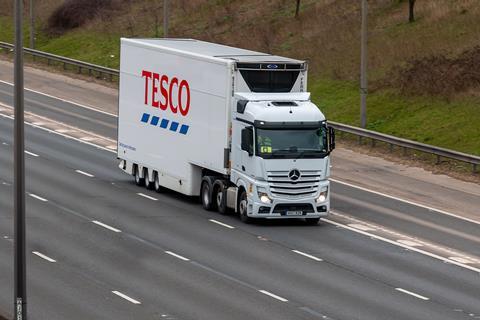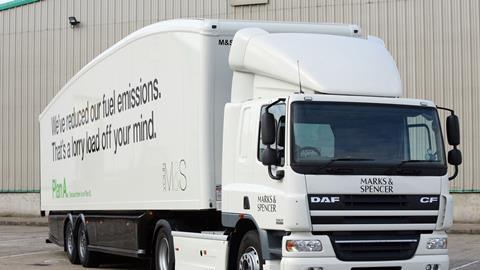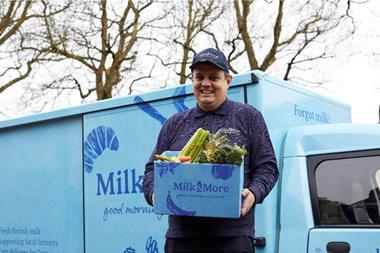In an increasingly volatile global market, British businesses are seeking to secure supply closer to home, making use of tech to boost efficiency
War in Ukraine, extreme weather, soaring costs, persisting Covid disruption and the prospect of complex and costly post-Brexit border checks have proved a tumultuous mix for the supply chain.
Food manufacturing costs are 33% higher than three years ago, according to the Food & Drink Federation, while the sheer number of unpredictable events has taken its toll on availability.
In response, British businesses have been looking to shorten supply chains by moving processes back to the UK (onshoring) or at least closer to home (nearshoring), and growing domestic stockpiles to buffer the immediate shocks to the system.
According to a survey of UK food and drink companies conducted for business advisory firm BDO last year, 65% say they have focused on onshoring or nearshoring.
So how are companies finding the shift homeward? What are the risks and rewards? And might the reaction to today’s issues also bring longer-term advantages?
In making these moves, businesses are finding it is both the best of times and the worst of times to bring operations back home. Global and domestic supply chain pressures have been giving business bosses sleepless nights, outranking access to labour, rising interest rates and mounting costs as the top concern facing more than half (54%) of mid-sized UK businesses over the next six months, according to BDO. Another BDO survey revealed more than three quarters (77%) were facing persistent disruptions within the supply chain.
“While the Covid-19 pandemic and Brexit have fallen out of the limelight, the supply chain pressures we’ve seen over the past few years are far from easing,” says BDO partner Ed Dwan.

Stockpiling
One way companies are weathering this, and attempting to mitigate new risks such as the recent collapse of the Black Sea grain deal, is by giving themselves the safety cushion of additional stockholding.
“Supply chains have become longer so we’ve had to stock more,” says Guy Tullberg, MD of chutney and relish brand Tracklements. Although the brand is supplied by UK growers, it also relies on imports. “We were thinking two to three weeks ahead, now it is more six to eight weeks.”
“We’ve got multiple ingredients in each of our products,” explains Tullberg. “If we don’t get mustard seed we don’t make mustard. But if we don’t get the spice, a really small part, we equally don’t make mustard. We’ve spent in order to make sure we are secure.”
Tracklements is not alone. Businesses are increasingly moving from ‘just in time’ supply chains to ‘just in case’ inventory management, says Simon Sutcliffe, partner at business advisory firm Blick Rothenberg. “However, such a move is not without its costs and still requires careful thought. If managed correctly then the security and sustainability of a company’s supply chain could be greatly improved.”
Inventory management software company Unleashed looked at data from thousands of manufacturers across all sectors and found they were typically spending twice as much on stock in 2022 as they were before the pandemic.
“What we’re seeing here, really, is the cost of caution”
Jarrod Adam, head of product at Unleashed
The ‘overstock’ figure – the actual stockholding value minus a calculated optimal stock level – for UK food manufacturers was £76,772, and for beverage companies £47,515.
“It’s a genuinely eye-opening number,” says Jarrod Adam, head of product at Unleashed. “What we’re seeing here, really, is the cost of caution.”
The financial and operational implications of stockpiling include a restricted cash flow, higher space requirements, and potentially additional labour and wastage risk, but there is value in it.
“While efficient processes such as just-in-time purchasing might help the bottom line,” says BDO’s Nick Eggett, “today it makes sense to sacrifice profits for predictability and opt for more resilient procurement strategies, for instance buying goods in bulk as a hedge against shortages.
“This is easier said than done, with lead times of natural ingredients often being lengthy, consumption profiles changing and variety of shelf-life limits influencing planning, amongst other factors,” he adds. “Managing the associated risks also comes at a cost but is the cost less than being unprepared for a disruption?”
It’s not only stock levels that can be ramped up locally. A January study by Economist Impact and DP World found almost all (96%) executives globally are reshoring or nearshoring their manufacturing and suppliers in response to geopolitical events. This is nearly double the figure of 2021.
And a survey of 750 UK brands by global fulfilment business ShipBob and research partner CensusWide last year found two in five were planning to manufacture domestically.

It can be a savvy move. Take Danish Crown’s new £100m, 30,500 sq m processing facility that’s due to come online in the coming months. The Rochdale site will produce more than 900 tonnes of bacon and gammon a week, and crucially be a “more sustainable way and provide a critical supply of bacon for the UK market” the company says.
Whether stockpiling or moving production processes, there is the question of where all the product will go. To extend its stockholding by 25% Tracklements, for example, needs 12,000 sq ft more space.
In good news for businesses like this, it’s not a bad time to be looking for warehouses, though. Latest figures from Savills show warehouse take-up for the first half of this year to be the lowest since 2013. Tenant demand for industrial space across the UK turned negative for the first time in 11 years in the second quarter of 2023, according to CoStar group analysis.
“Weakening demand for distribution and storage facilities comes as retailers and third-party logistics companies seek to reduce their cost bases,” says Grant Lonsdale, director of market analytics at CoStar.
Many businesses are offloading the space they raced to acquire during the pandemic online boom. In January, Amazon revealed it was shuttering three UK warehouses – some 1.2 million sq ft – and replacing them with two new distribution centres. More recently it announced the closure of its 700,000 sq ft Rugeley fulfilment centre, which is to be replaced with a smaller facility in Sutton Coldfield.
Some in the grocery sector have released surplus warehouse space back on the market this year. Hotel Chocolat is now subleasing nearly half the 430,000 sq ft it secured on a 10-year lease at Panattoni Park Northampton little more than a year ago.
“The chocolate manufacturer is not alone in having expanded its distribution space during the pandemic and then cut back amid a return to more normal trading patterns,” says Lonsdale. “Dedicated third-party logistics firms are also trimming their footprints.”

Demand for space
But many food businesses are bucking the broader trend. Demand from food manufacturers and businesses for shed space increased 58% last year to a record 4.3 million sq ft, according to Savills.
That’s the biggest take-up from the sector since Savills started collecting the data in 2007. And with demand so low generally, good deals can be struck.
So far, so good for businesses looking to onshore – but the challenges in doing so can be significant.
Although BDO found that 46% of UK food businesses said the process of adapting supply chains had gone smoothly, 43% reported difficulties in adjusting supplier and contract strategies.
Labour can also be an issue, with the FDF’s latest industry snapshot showing that labour vacancies are falling slightly but “remain uncomfortably high” at 5.9%, almost double the rate of the rest of UK manufacturing.
“Labour shortages continue to hold back growth – with some manufacturers unable to take on new orders due to the lack of available staff and skills,” the FDF report notes.
And food inflation, while appearing to have peaked, remains high. Office for National Statistics data shows that over the first four months of the year, total input costs for food manufacturers were 16.3% higher year on year, with UK-sourced ingredients up 14.3% and imported ingredients up 27.5%.
Given that manufacturers often use long-term purchasing contracts, for many there will be a delay before they can take advantage of slightly improving market conditions. Add in high transport and logistics costs and it is a tricky time to invest.
“Manufacturers are seeing a gradually improving picture but the word ‘gradually’ is doing a lot of heavy lifting,” says James Brougham, senior economist at Make UK.
Those that can invest in local operations are taking the opportunity to optimise them, with technology playing an important role.
“As it becomes harder to efficiently move goods through Europe, many companies aim to have a reliable supply chain within the UK,” says Rowan Stott, research analyst at Interact Analysis, adding that the need for more locally made and stored goods can be expected to have an impact on distribution centre automation.
Interact Analysis predicts demand for warehouse robots and automation will continue to rise – though by less than previously predicted due to slowing warehouse construction.
“Is the cost less than being unprepared for a disruption?”
Nick Eggett, BDO
The demands of onshored food and drink businesses will lead to an increase in “automated pallet handling systems and palletising solutions to distribute items through the supply chain at a faster rate, while having better visibility of the goods within the facilities” says Stott.
“The visibility of goods within the supply chain will become more important as stock begins to pile up, which can be improved by using automated systems and software within the sites,” he adds.

DHL says it is keeping storage costs down for clients by using automation to maximise storage density, enabling customers to store more in smaller spaces.
“One way we are doing this is through incorporating high-bay warehousing and automation including automated storage retrieval systems, which enable more pallets to be stored in a smaller area, stretching storage capacity,” explains DHL Supply Chain UK&I chief executive Saul Resnick.
Sustainability
Some businesses are investing in renewable energy supplies to cushion them from volatile global markets.
Arla this month announced the opening of two new solar parks, in Boston in Lincolnshire, and Offham in Kent, that will supply around 20% of the energy needed to power its entire UK operation from renewable sources.
The shift to the UK could also reduce the food miles involved with production, a priority for major retailers and their net zero commitments. Consumers care too. According to IGD, 81% believe the UK should be more self-sufficient when it comes to food production.
While there are signs confidence in global supply chains is returning, it seems likely UK businesses will continue to consider onshoring and nearshoring as valuable options that can offer sustainability benefits alongside much-needed supply chain resilience.
The race for onshoring: How Britain’s food supply is coming home
- 1
 Currently reading
Currently readingThe race for onshoring: How Britain’s food supply is coming home
- 2





















No comments yet